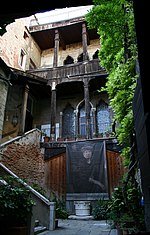Palazzo Fortuny
The Palazzo Fortuny (formerly: Palazzo Pesaro degli Orfei ) is a 15th century palace, built by the Pesaro family , in the sestiere of San Marco in Venice . The house got its current name from its last owner, Mariano Fortuny y Madrazo (1871–1949); it has housed a museum on the first floor since 1956.
history
The Pesaros, who provided a doge to the city with their member Giovanni Pesaro in the 17th century , had been one of the most influential families in Venice since the Middle Ages. Around 1470, the family had the largest palace in the city built at the time on Campo San Beneto, which encompassed an entire residential district. The building, arranged around two inner courtyards, was given two facades, one facing the Campo, the public square, and the other facing the narrow canal. In between, a 45-meter-long hall was built as a connection. The complex floor plan is reflected in the facades, which are richly structured but asymmetrically laid out by multi-section loggias and Gothic triforias .
The spacious house was a theater in the 17th century, and was used as a concert hall in the 18th century, giving the Palazzo Pesaro the addition of degli Orfei to its name . In 1892 it was bought by the sculptor, architect and inventor Mariano Fortuny, after whom it is named today.
museum
Fortuny lived and worked in the palazzo until his death in 1949. His widow Henriette bequeathed the building with all its interior to the city of Venice in 1956. On the first floor, the piano nobile , a museum was set up that shows Fortuny's work, including models for stage structures and lighting, textile samples, oil paintings, including those of his father, Marià Fortuny i Carbó , and marble torsos, as well as clothes and fabrics in that of Mariano Fortuny y Madrazo rediscovered the ancient technique of plissé . From 1980 to 1998, the Palazzo Fortuny also housed the Guidi Museum, dedicated to the painter Virgilio Guidi.
literature
- Richard Goy: City in the lagoon. Living and building in Venice . Knesebeck, Munich 1998. ISBN 3-89660-030-3
Web links
Individual evidence
- ^ Richard Goy: Stadt in der Lagune (1998), p. 263
- ^ Walter M. Weiss: Venice . Dumont, Cologne 1995, p. 104
- ↑ Virgilio Guidi. In: associazione.miroromagna.it. Retrieved February 11, 2020 (Italian).
Coordinates: 45 ° 26 ′ 8 ″ N , 12 ° 19 ′ 56.3 ″ E





